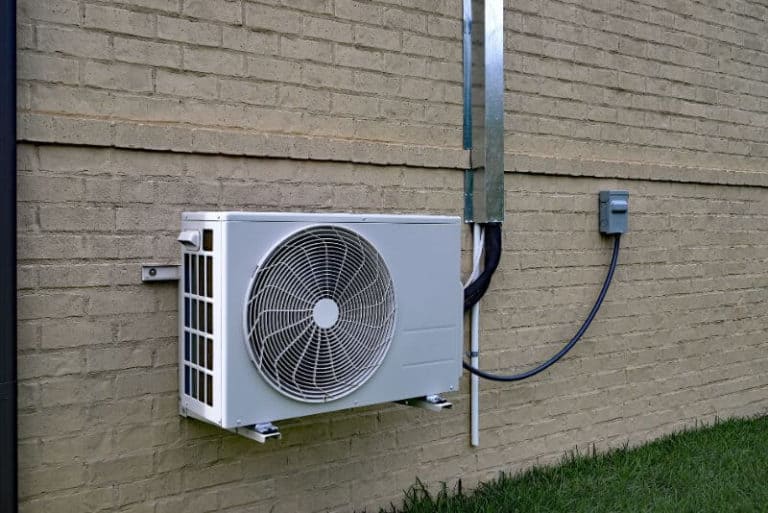Split systems come in a variety of types, such as air conditioning or heat pump systems—bigger homes may need multiple split system air conditioners—that are put outside of your house and connected to a gas furnace or a fan coil inside. Let’s learn more what is a split system heat pump.
Types Of Heating And Cooling Systems For Split Systems
Furnaces
Indoor machines called furnaces heat the air in your house by burning fuel, such as gas or propane, and then distributing the heated air throughout your house’s ducts.
Fan Coils
Indoor fan coils circulate air over the coil, which, depending on the season and weather, heats or cools it before distributing it throughout your house’s duct system.
Split System Air Conditioners
The condenser and compressor of a split-system air conditioner can be found out in the open, while the evaporator unit, furnace, air handler, and filters can be found indoors.
Split System Heat Pump
Heat pumps are powered by electricity that transmits heat from outdoor air, including cold air, indoors. The indoor unit circulates the air within the house with a fan and air handler, while the outdoor unit has a compressor and heat exchanger.
Ductless And Ducted Systems
HVAC split systems can be either ductless or ducted. The warm air produced by your furnace, fan coil, or heat pump, as well as the cool air produced by your air conditioner, heat pump, or fan coil, are circulated via ductwork in ducted split systems. Small air handlers placed in particular locations throughout your house are used by ductless mini-split systems to heat or cool those particular spaces.
Get To Know What Is A Split System Heat Pump
Let’s go deep and get to know what is a split system heat pump.
Split system heat pumps are typically ductless, in contrast to a lot of traditional heat pump systems. One of the split system’s many benefits is made possible by this. A single outdoor condenser can be connected to several indoor air handlers in many of these system variations. To maintain a certain temperature in each room, each of these indoor air handlers can be set by a separate thermostat. Having control over individual rooms saves energy and money.
When a duct system is not used, the heat pump substitutes for 30% of the energy that is frequently lost throughout the ductwork. Rather, the air handler distributes the air straight into the room. Air handlers are far more flexible in terms of design since they may be positioned anywhere—on the wall, the floor, or even the ceiling—without being constrained by a duct system. By replacing the duct structure required for packaged heat pumps and traditional HVAC systems, the split system heat pump redefines efficiency.
Split System Heat Pump Key Components
Both homeowners and businesses frequently use split system heat pumps as a form of heating and cooling equipment. Since it has two primary parts—one within the structure and one outside—it is referred to as a “split” system. Depending on the season, these systems can both heat and cool structures, making them efficient.
Indoor Unit – Evaporator Coil
Usually, this part is mounted inside the structure, frequently in the wall or ceiling. It has an evaporator coil, which exchanges heat with the building’s interior air to aid in heating and cooling.
Outdoor Unit – Condenser Coil
The system, which is outside the structure, houses the compressor and condenser coil. Depending on the season, it is in charge of either absorbing or releasing heat. It emits heat into the atmosphere when cooling and takes in heat from the surrounding air when heating.
How Split System Heat Pump Works
Heating Mode
When it is in heating mode, heat is transferred indoors from the outside air—even in cold weather. This is made possible by the ability of a heat pump to reverse the flow of refrigerant, causing the condenser coil to become the evaporator coil and the evaporator coil to become the condenser coil.
Cooling Mode
It’s the opposite of heating mode. Heat is extracted from indoor air by the unit and released outside.
Split System Heat Pump Benefits
Its hardly noticeable performance is the main benefit of a split system heat pump. It has been constructed and developed to alter deep noises that are thought to be upsetting to a higher frequency. Most split system heat pumps also have a night mode that further lowers the sound power. It is safe to use in places with extremely stringent sound emission regulations, including terraced homes or luxury resorts.
Split system heat pumps have been prepared for reverse operation, feature a small inside footprint, and operate quietly. With the use of convectors or surface cooling systems, they are able to chill rooms to the proper temperature during the sweltering summer months. They can be expanded because of their modular architecture. If their heating or cooling demands grow, system owners can maintain a high degree of flexibility and install more heat pumps.
Other benefits of split heat pumps include:
· All set to connect to a solar power system
· Extremely convenient operation with remote control via app, tablet or smartphone
· High efficiency at every functioning point results in low operating expenses.
· Simple-to-use control unit with a visual interface and plain text
These split air source heat pumps are perfect for new construction and renovations, either as heating-only systems or as heating-and-cooling systems. With this design, there is no need for expensive wall outlets or air duct routing.
What Are Traditional HVAC Systems?
Furnace + Central Air Conditioner
- A furnace heats the air, while a central air conditioner (AC) cools it.
- Uses ducts to distribute air throughout the home.
- Typically, two separate systems—one for heating and one for cooling.
Boiler + Radiators
- A boiler heats water and sends it to radiators or baseboard units to warm the home.
- Cooling typically requires a separate air conditioner.
- Ideal for consistent heat, often in older homes.
Packaged HVAC Systems
- Combines both heating and cooling into one outdoor unit.
- Common in smaller homes or commercial buildings.
- Uses ductwork for air distribution.
Electric Baseboard Heaters
- Electric resistance heaters are installed in rooms.
- Heating is done room by room, with no ducts.
- Cooling requires a separate air conditioning unit.
Split System Heat Pump vs. Traditional HVAC Systems
|
Feature |
Split System Heat Pump |
Traditional HVAC Systems |
|
Heating + Cooling in One |
✅ Yes – one system does both |
❌ No – separate systems for heating (furnace/boiler) and cooling (AC) |
|
Ductwork Required |
❌ No – often ductless (mini-split systems) |
✅ Yes – uses ductwork (except for electric baseboard heaters) |
|
Energy Efficiency |
✅ High – uses heat transfer instead of generation |
⚠️ Moderate – older units or oversized systems use more energy |
|
Room-by-Room Control |
✅ Yes – independent thermostats for each room/zone |
❌ No single thermostat for an entire home |
|
Installation |
🛠️ Flexible – easy in retrofits or homes without ducts |
🛠️ Complex – may require ductwork and larger units |
|
Best For |
Homes without ducts, smaller spaces, and energy-conscious users |
Larger homes, areas with existing ducts, and cold climates |
|
Noise Levels |
🔇 Quiet – especially with mini-split systems |
🔊 Can be noisy, especially with older systems like furnaces |
|
Cooling Method |
Reverses the flow for cooling |
A separate cooling unit (AC) is needed |
|
Heating in Cold Weather |
Works well in mild to moderate climates, inverter tech |
Furnace/boiler works better in very cold weather |
Energy-efficient HVAC systems: Which System is Right for You?
Conclusion
What is a split system heat pump do to your house? You can save money by using a split system heat pump. A lot of individuals nationwide demand efficient winter heating and consistent summer cooling.
The temperature can fluctuate between uncomfortable warmth and cold in the early spring or late autumn. You might change it on your boiler or furnace. However, a more effective heat pump that can supply all your heating needs in moderate weather will help you save money. Also, a split system heat pump is all that many houses need to survive the winter. A heat pump is a good choice for those who reside in the blazing southwest or the tropical southeast.
A split system heat pump is an everyday, effective, and adaptable heating and cooling option. It saves space and energy!



